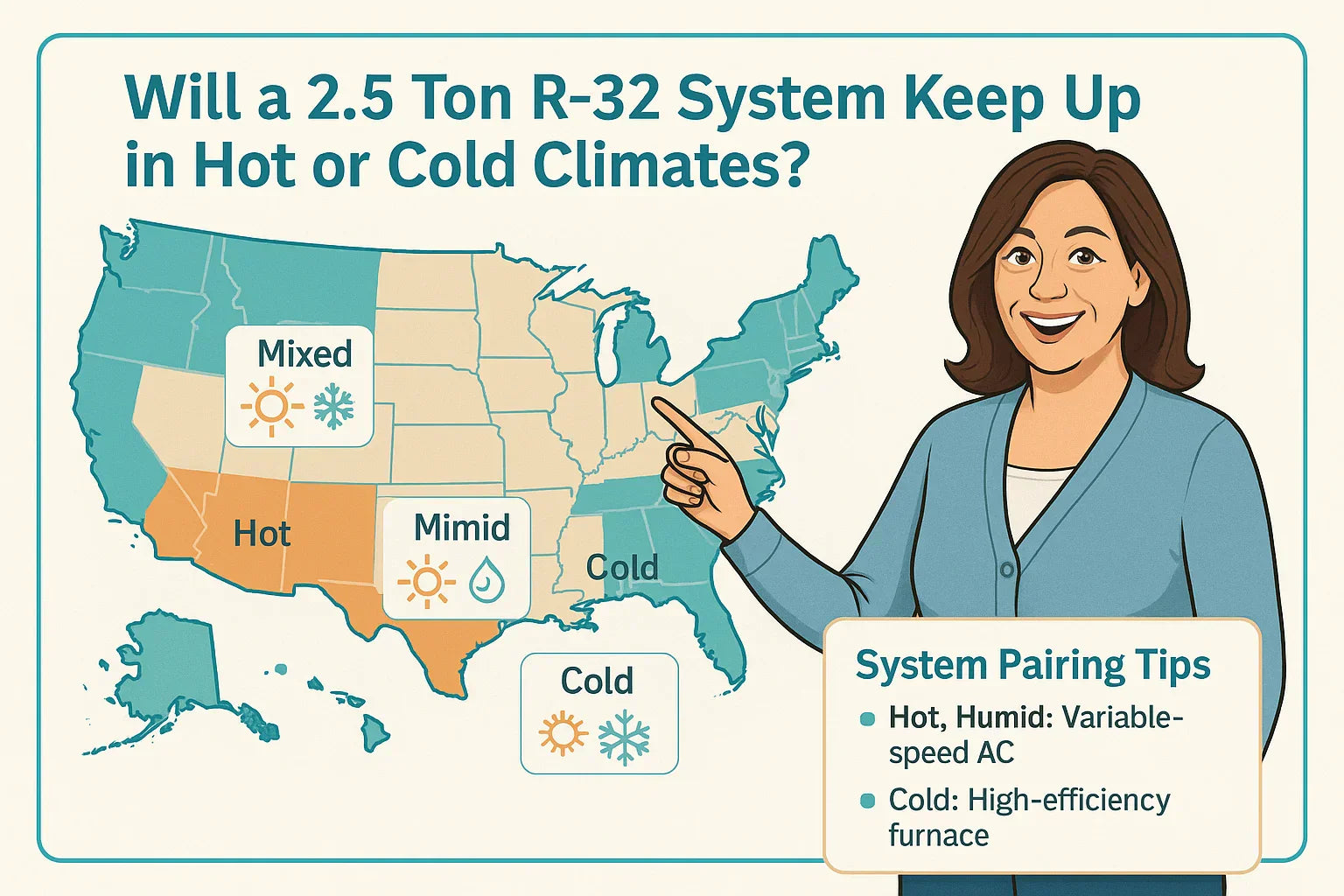Choosing a new HVAC system isn't just about tonnage or energy efficiency — your climate zone plays a major role in system performance. If you’re considering a 2.5-ton R-32 system, you may be wondering: Will it cool effectively in the summer heat? Will it keep up during winter’s chill?
This guide answers those questions by exploring how R-32 systems perform across climate zones, what features matter most in extreme temps, and how to match the right 2.5-ton setup to your local conditions.
🧊 What Is R-32 and Why It Performs Better in Heat
R-32 (difluoromethane) is a next-gen refrigerant known for its:
-
High thermal conductivity (better heat exchange)
-
Lower global warming potential (GWP = 675 vs. R-410A’s 2,088)
-
Improved compressor efficiency
These benefits make R-32 systems especially well-suited for high-performance cooling in hot climates — particularly when paired with variable-speed compressors and SEER2 ratings above 15.
👉 Learn more: EPA Guide on Low-GWP Refrigerants
🏜️ How 2.5-Ton R-32 Systems Handle Hot Climates
In hot, dry regions like Arizona, Nevada, and parts of Texas or California:
-
A 2.5-ton R-32 system can cool homes up to 1,500–1,600 sq. ft. effectively
-
Look for systems with variable-speed compressors for smoother temp control
-
Use SEER2 15+ models to keep energy bills down
-
Consider a smart thermostat to optimize run times and avoid peak energy costs
Important: Oversizing to 3.0 tons might reduce humidity control and waste energy.
💧 How They Perform in Humid Areas
In humid climates like the Gulf Coast or Southeast:
-
Prioritize systems with longer run cycles for moisture removal
-
Use variable-speed air handlers to improve dehumidification
-
Make sure ducts are sealed to prevent indoor humidity gains
R-32 enhances coil efficiency, which helps with faster cooling and slightly better moisture control than R-410A systems.
❄️ What About Cold Climates?
R-32 systems are effective in mild to moderate winters, especially when:
-
Paired with dual fuel systems (heat pump + gas furnace)
-
SEER2 ratings are complemented by high HSPF2 values (7.5+)
-
Thermostats are set to switch over to gas below 35°F
If your region frequently sees temps below 15°F, consider:
-
A cold-climate heat pump
-
A furnace-forward dual fuel configuration
👉 ENERGY STAR Cold Climate Certified Heat Pumps
🏠 Matching Tonnage to Climate Zone
| Climate Zone | Typical Sq. Ft. for 2.5 Tons | Notes |
|---|---|---|
| Hot/Dry (Zone 1) | 1,200–1,400 sq. ft. | Prioritize SEER2 & airflow |
| Hot/Humid (Zone 2) | 1,000–1,300 sq. ft. | Emphasize dehumidification |
| Mixed (Zone 3–4) | 1,300–1,600 sq. ft. | Best fit for 2.5 tons |
| Cold (Zone 5–7) | Dual fuel suggested | Add furnace support below 35°F |
Use a Manual J load calculation to confirm tonnage needs.
🧭 How to Optimize for Your Region
Hot Regions:
-
Upgrade attic insulation
-
Shade outdoor condenser
-
Schedule annual coil cleanings
Humid Regions:
-
Use a programmable thermostat
-
Run ceiling fans to reduce reliance on AC
Cold Regions:
-
Choose a matched dual fuel setup
-
Ensure ducts are insulated in attics/basements
💬 Samantha’s Smart Climate Tips
“Your square footage may be the same as your cousin’s in Arizona, but if you live in Ohio or Georgia, your system’s needs are totally different. Always consider climate zone AND home layout when picking your system.”
✅ Final Takeaway: 2.5 Tons Works — If It’s Matched to Your Climate
A 2.5-ton R-32 HVAC system can be an excellent choice in a variety of U.S. climate zones. The key is:
-
Pairing the system with the right features (SEER2, dual fuel, smart controls)
-
Sizing it correctly for your square footage and region
-
Choosing a certified installer familiar with R-32 performance tuning
👉 Explore R-32 HVAC systems by tonnage and region at The Furnace Outlet
In the next topic we will kow more about: Will a 2.5 Ton R-32 System Keep Up in Hot or Cold Climates?







